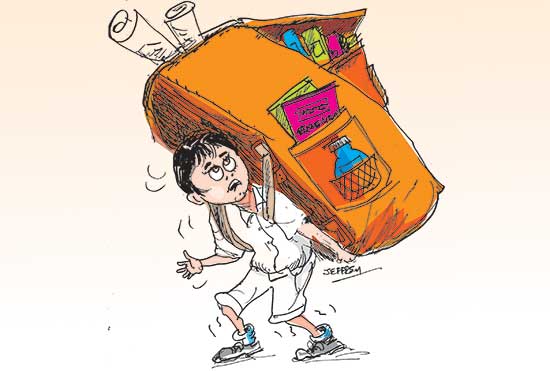Features
Reduce O/Level STRESS

by Anton Peiris,
B.Sc. (Ceylon), PGCE (Kenya ), M.Sc. ( London ), DAES (York )
Emeritus Coordinator, International Baccalaureate, Switzerland
There is intense stress for the students, they have hardly any time for play or extracurricular activities. Their life is complicated by the necessity to attend ‘tuition classes ‘. They have to study 9 subjects for O/L Exams as opposed to 7 subjects for students in England and Europe. When the O/L Exam time comes up, they become unbalanced psychological wrecks.
This problem can be solved. My recommendations are given below:
The number of subjects studied for O/L Exams should be reduced to 7.
Consider the package given below:
Sinhala Language, English Language, Mathematics or an easier option called Maths Studies, General Science , History, Religion , Another Subject (7th subject). Total seven subjects.
Instead of taking nine subjects in O/L Exams, students will be able to take only seven, thereby reducing their stress considerably.
The package given above will provide a balanced education. Teaching seven subjects for O/L exam will provide spaces in the Time Table (in Grades 6 – 11) for teaching Computer Studies and Art or Music or Dancing or Health Science or another subject to all students (in addition to the 7 subjects). These subjects should be internally assessed, there should be no homework set and, for the majority of students, there is no necessity to offer these subjects for O/L exam. Students have the option of taking one of these subjects or literature as their seventh exam subject in the package given above. In many countries, students do not offer Computer Studies as a subject for O/L Exams. All students follow a course in typing and computer studies and obtain a diploma in that subject (e .g. ICDL – International Computer Driving Licence ) while still in school.
Candidates taking History for O/L have already followed a course in Geography in the middle school Grades 6 – 8).
It is not necessary to offer everything you study in school as subjects for O/L exam.
The package of 7 subjects given above plus computer skills plus CAS is designed to impart an all-round education.
Maths Studies for ‘O’ Level Exams: There are students who have very little or no ability in mathematics and also others who do not need the use of this subject for their future studies. I suggest that they follow a course in Maths Studies in Grades 9 – 11 and sit an O/L Exam called ‘Maths Studies Exam ’. The Maths Studies course should aim to demonstrate some practical applications of mathematics, e.g. percentages, use of compound interest formula, elementary statistics including standard deviation, elementary probability including permutations and combinations, use of the Z- Score formula and the Normal Curve (the bell shaped curve) and use of Spearman’s Rank Correlation formula (no proofs required in any of the formulae), plus elementary Arithmetic, Algebra , Geometry and simple Trigonometry of the Right Angled Triangle (some of which they have already studied in the Middle School) plus emphasis on graphical work. This idea is nothing new. International Baccalaureate had a Maths Studies programme from 1970 to 2018. More than a million ‘weak ‘ students all over the world have discovered that this course is within their capability and they have obtained the IB Maths Studies Exam qualification.
Maths Studies course will also equip our students with a few useful life skills. e.g. Use of the compound interest formula will enable them to calculate in advance how much Interest and the Amount of money that they will get in their Savings Accounts. Simple exercises in Permutations, Combinations and Probability will sharpen their ability to do critical thinking. The simple method of calculation using the Coefficient of Rank Correlation formula will enable them to compare two sets of statistical data and obtain a meaningful result. The simple Z- Score formula also has practical applications.
Maths Studies should be an easier option, i.e. about 80 % of the O/L Maths Studies exam should consist of straightforward questions. e.g. to calculate the third side given two sides of a right angled triangle (pythagoras) or to calculate a side or an angle of a right angled triangle using simple trigonometry (sine or cos or tan) or to calculate the standard deviation given two columns (score and frequency) followed by a direct substitution of the result in the simple Z Score formula and to read the Answer using the Normal Curve Statistical tables.
Parents spend thousands of rupees per month on private tuition classes in mathematics for ‘weak ‘ students. Maths Studies course can stop this waste of money because weak students will realize that this course is within their capability. More than a million weak’ students all over the world have been comfortable with statistical topics like Standard Deviation, Z-Score formula and Coefficient of Rank Correlation because these topics involve only Addition, Subtraction, Multiplication and Division; that is, simple Arithmetic.
Maths Studies course should provide sufficient mathematical background for students planning to start courses in Technical/Vocational training, Agriculture or Medicine.
To be continued. Next instalment: CAS for Secondary students.
The writer has taught O/L, A/L and IB mathematics for 45 years in Sri Lanka, Kenya and Switzerland.)